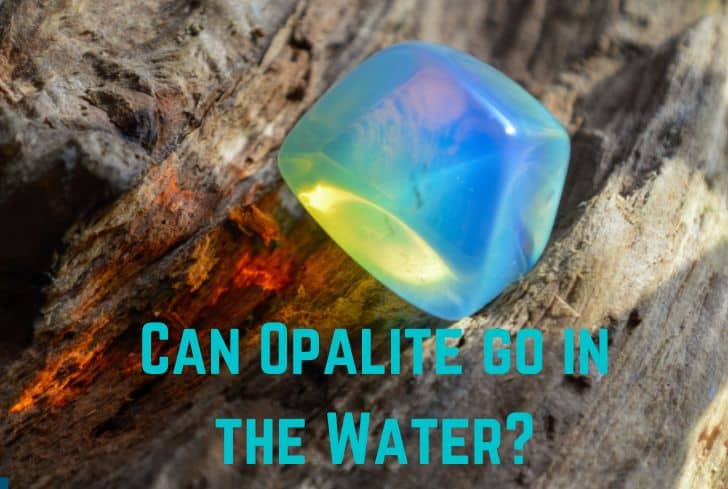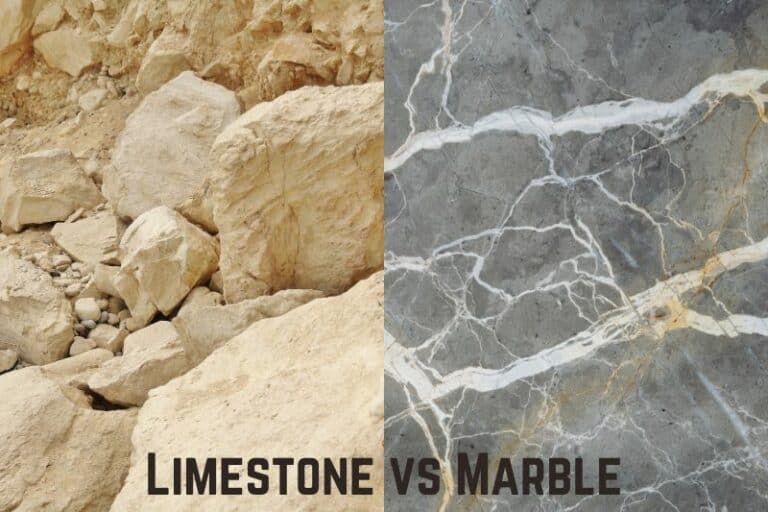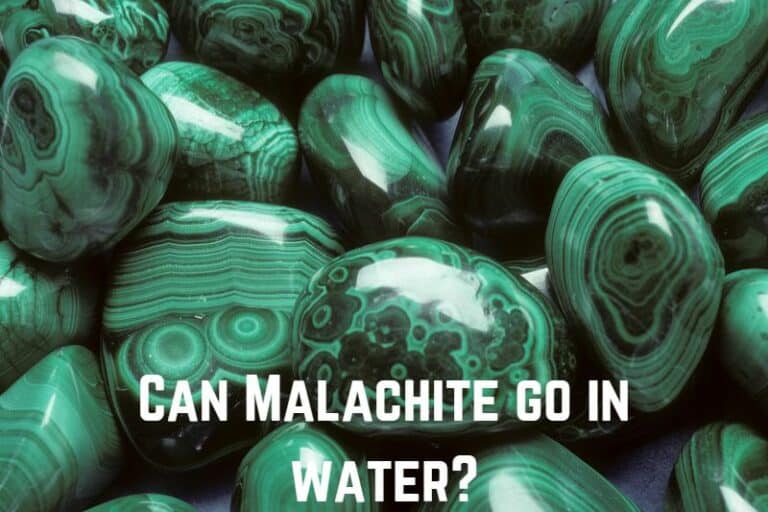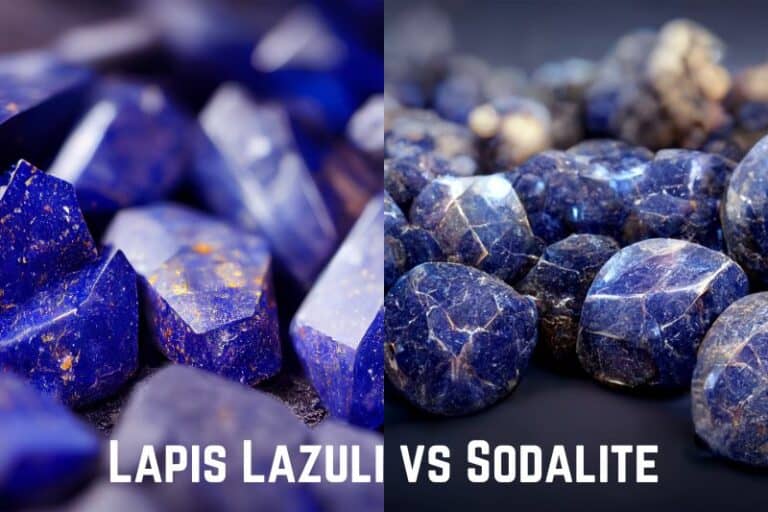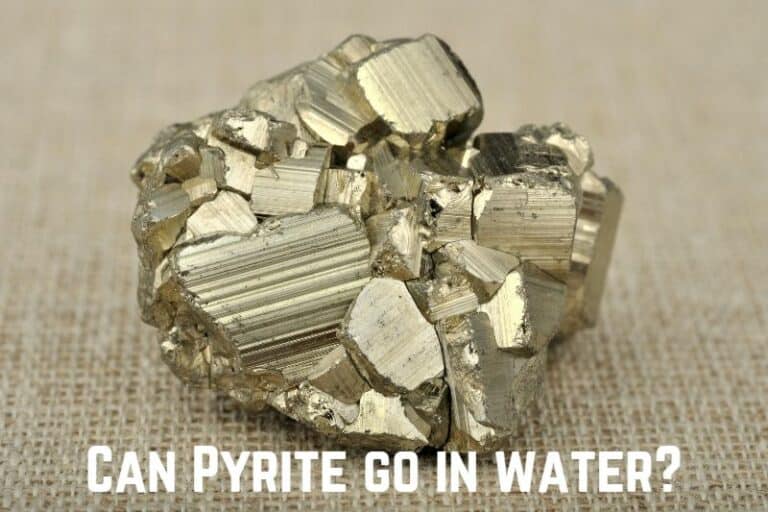15 Exquisite Blue Rocks, Gems and Minerals (+Pics)

Blue rocks, gems, and minerals have captivated people’s imaginations for centuries with their stunning hues and unique properties. As you delve into the world of these beautiful natural wonders, you’ll undoubtedly be amazed by the incredible variety and countless examples of nature’s artistry.
Throughout history, these vibrant blue gems and minerals have been prized for their beauty and rarity, with some even believed to hold mystical powers. From the deep blue of sapphires to the captivating shades of turquoise, you’ll find that each of these rocks has its own story to tell and fascinating characteristics to discover.
As you explore the 15 different types of blue rocks, gems, and minerals, prepare to embark on a journey into the depths of the Earth’s crust, where you’ll learn about the formation, significance, and unique properties of these natural masterpieces, giving you a newfound appreciation for the stunning wonders of our planet.
15 Types of Blue Rocks and Minerals
1. Sapphire

Sapphire is a stunning gemstone that is known for its deep, velvety blue hue, which ranges from greenish blue to violetish blue. It belongs to the mineral species corundum and is considered one of the most popular blue gemstones available. As a cherished gem, sapphires are perfect for your jewelry collection or as a gift for someone special.
When looking at sapphires, you’ll notice that their beautiful blue hues can vary. The most desirable color is a rich, intense, and medium-dark tone that catches the eye. However, lighter tones may appear washed out, and darker tones might seem inky or steely. You can also find sapphires in a variety of shades, such as cornflower blue and royal blue.
Sapphires are not only popular for their beautiful colors but also for their durability and hardness. With a rating of 9 on the Mohs scale, they rank just below diamonds, making them suitable for everyday wear. This means your sapphire jewelry will maintain its striking appearance and resist scratches and damage.
In addition to their beauty and durability, sapphires also have a rich history. They have long been associated with royalty, wisdom, and divine favor. These gemstones were believed to protect their wearers from harm and attract blessings from the heavens.
When considering a sapphire for your jewelry collection, remember to pay attention to its color, clarity, cut, and carat weight. A well-cut sapphire can exhibit mesmerizing brilliance and sparkle, capturing light from all angles. You may also want to consider the origin of the gemstone, as sapphires from different locations can vary in color saturation and quality. Some of the most sought-after sapphires come from countries like Sri Lanka, Madagascar, and Myanmar.
In conclusion, sapphires are an enchanting, durable, and versatile gemstone with deep historical and symbolic significance. So, the next time you want to add a touch of elegance and sophistication to your jewelry collection or gift a loved one with a meaningful piece, consider the captivating charm of a sapphire.
2. Aquamarine
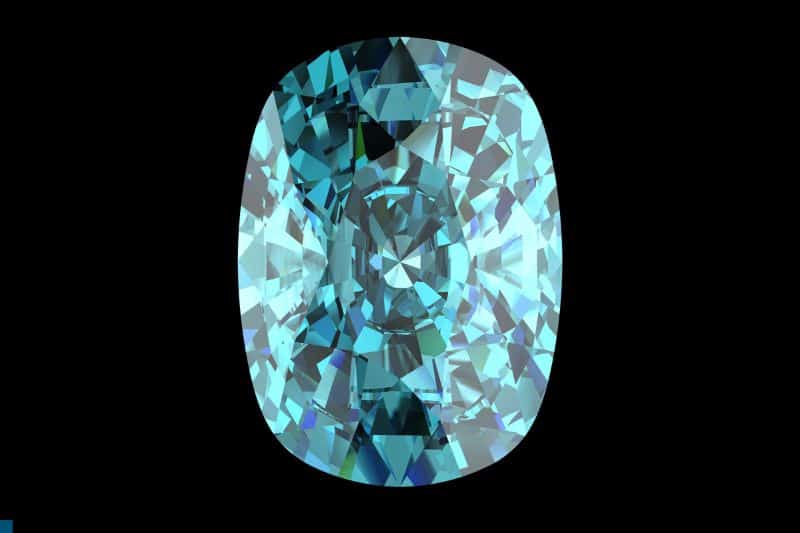
Aquamarine, a beautiful green-blue to blue variety of the mineral beryl, is a gemstone that has captivated people for centuries. When you look at aquamarine, you’ll notice its light pastel greenish-blue color that gives off a serene and calming vibe. This makes it perfect for anyone seeking a piece of jewelry that evokes a sense of tranquility source.
This gemstone not only looks stunning, but it also has a fascinating geological occurrence. Aquamarine forms in the earth’s crust through natural processes and is often found in granite pegmatites and sometimes in hydrothermal veins source. It is a highly sought-after stone, especially for those born in March, as it serves as a birthstone option alongside the cabochon-cut bloodstone.
When considering aquamarine for a piece of jewelry or a collection, you’ll come across different shapes and cuts. For instance, you might see aquamarine in stunning faceted cuts or even in its raw, natural crystal form. As you explore different aquamarines, pay attention to the characteristics and quality of the stone. A well-cut, high-quality aquamarine gemstone will have an even color, with minimal inclusions or blemishes, and great clarity.
As you add aquamarine to your collection or incorporate it into your style, appreciate its mesmerizing color and natural beauty. You’ll surely enjoy the calm and soothing effect that this enchanting gemstone brings to your life. Remember to take proper care of your aquamarine pieces, as it has a hardness of 7.5 to 8 on the Mohs scale, making it durable, but also susceptible to scratches and damage if not treated with care. Happy aquamarine hunting!
3. Tanzanite
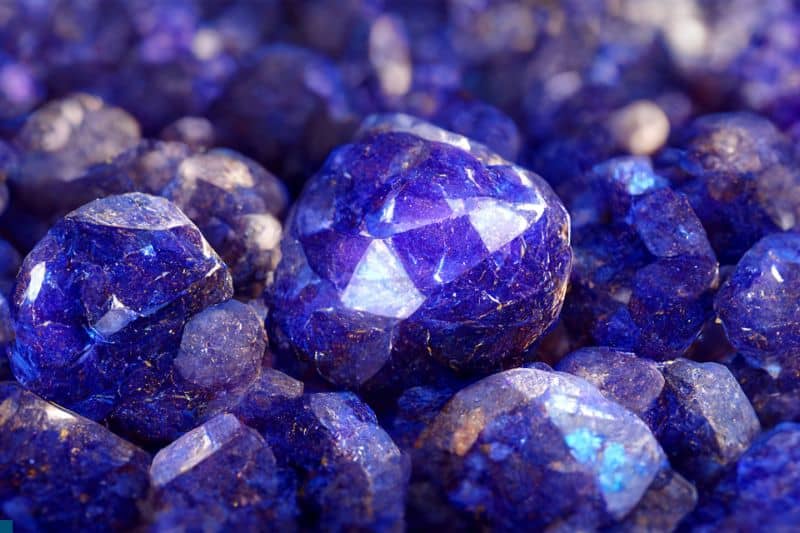
Tanzanite is an extraordinary gemstone known for its captivating violet-blue hues. This stunning stone is a transparent variety of the mineral zoisite. As you dive into the world of tanzanite, you’ll learn that it is much more than just a beautiful gem.
Discovered in Tanzania near Mount Kilimanjaro, tanzanite was formed around 585 million years ago during the mid-Ediacaran Period due to massive plate tectonic activity and intense heat in the area. You’ll find that tanzanite deposits are usually located in complex geological environments, often in the hinge of isoclinal folds.
One fascinating feature of tanzanite is its pleochroism—the gemstone’s ability to show different colors when viewed in different crystal directions. This unique attribute adds depth and vibrancy to tanzanite, making it even more desirable.
In terms of gem quality, tanzanite’s color and clarity play a significant role. A top-rated tanzanite, like an 8.14-carat faceted oval, would be considered rare and highly valuable. Besides its beauty, tanzanite also has some functional properties, such as a specific gravity of 3.35 and a Mohs hardness of 6 to 7.
When you wear or admire tanzanite jewelry, remember this gemstone’s unique geological journey and the mesmerizing characteristics that set it apart from other blue rocks, gems, and minerals.
4. Azurite

Azurite is a captivating blue mineral that has intrigued collectors for centuries. Known for its brilliant blue hues and unique properties, it is a secondary mineral that forms when carbon-dioxide-laden waters descend into the Earth and react with subsurface copper ores (Geology.com). You’ll find this gemstone particularly captivating due to its deep and rich coloration.
As you inspect azurite, you will notice its color ranges from bright blue to a more subtle, violet-blue shade. This gemstone is used in various applications, like polishing into cabochons and beads or even being carved into ornamental objects. An interesting combination you might come across is “azure-malachite,” which is a mixture of blue azurite and green malachite. This blend is also carved as cabochons and beads, making it popular among collectors (Minerals.net).
Azurite’s chemical formula is Cu3(CO3)2(OH)2, meaning it contains copper (II) cations linked to two different anions, carbonate and hydroxide (Wikipedia). This distinctive chemical structure contributes to the stunning colors and properties that you find in the mineral.
In your exploration of blue rocks, gems, and minerals, make sure to pay special attention to azurite. Its striking colors and unique formation process will surely leave an impression on you. And when you are showing your collection, this dazzling gemstone will undoubtedly be a conversation starter among your friends and fellow collectors.
5. Apatite
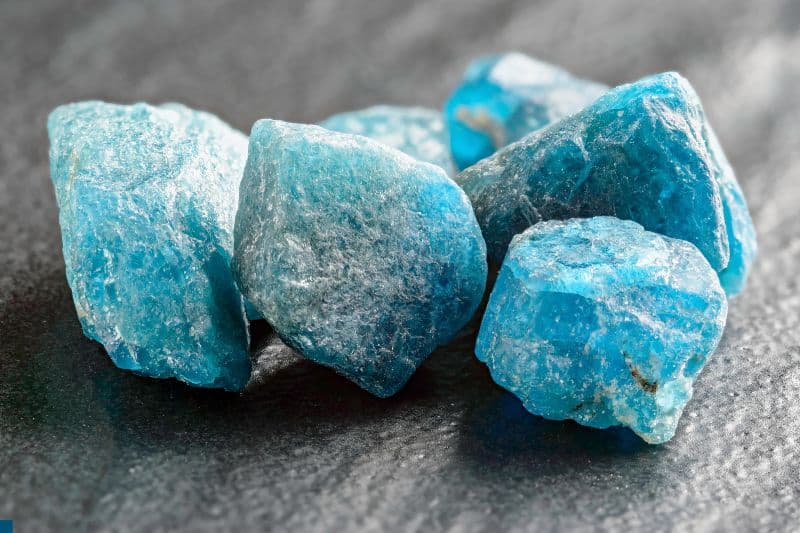
Apatite is a fascinating blue gemstone that you might love to learn about. It belongs to a group of phosphate minerals, which usually include hydroxyapatite, fluorapatite, and chlorapatite, depending on the concentrations of OH−, F−, and Cl− ions in the crystal structure ¹.
One of the striking features of apatite is its range of colors, from green to yellow, brown, blue, purple, pink, or even colorless ². However, the blue variety of apatite, commonly known as “Neon Blue” or “Brazil Blue,” is especially prized for its vibrant hues and eye-catching appearance.
As a mineral, apatite has a hardness of 5 on the Mohs Hardness Scale ³. This makes it a relatively soft gemstone compared to others like diamonds or sapphires. Nevertheless, its vivid colors make it popular among gemstone collectors and jewelry enthusiasts.
When you find apatite in its natural state, you might notice that it often comes in massive crystals, which can be cut and faceted into stunning gemstones ⁴. The “Neon Blue” apatite, in particular, is recognized for its electric blue-green hues that captivate the eye and make for truly unique jewelry pieces ⁵.
In summary, apatite is a beautiful and versatile blue gemstone that can add a touch of color and elegance to your collection. It offers a fascinating insight into the world of blue rocks, minerals, and gemstones, showcasing the incredible diversity and beauty of nature’s creations.
6. Lazurite
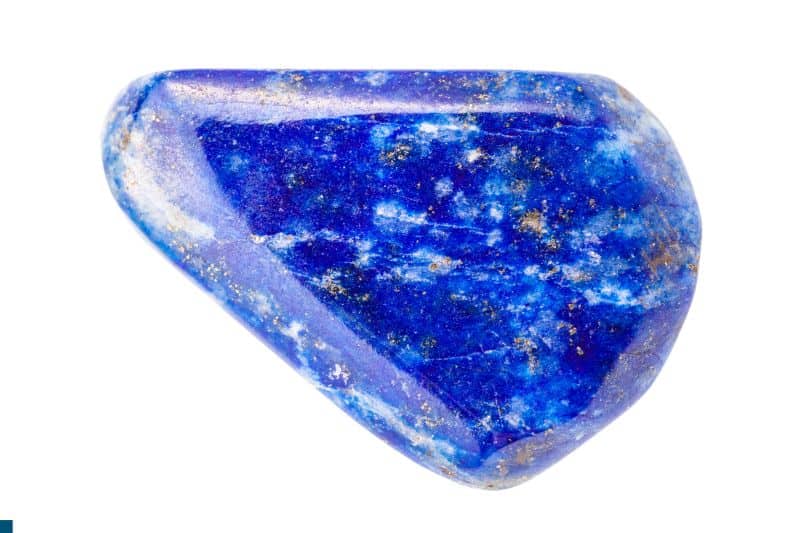
Lazurite is a fascinating blue mineral that’s often found in the beautiful gemstone known as lapis lazuli. It’s the ingredient responsible for producing lapis lazuli’s most prized color, which is bright royal blue. This ancient rock is an aggregate of several minerals, including lazurite, calcite, and pyrite. It can also contain lesser amounts of other minerals such as diopside, amphibole, feldspar, or mica.
You might come across lazurite in various forms, such as raw crystals, polished stones, or as an essential component of stunning jewelry pieces. When examining lazurite, look for its deep blue color and characteristic crystal habit. Keep in mind that it can be confused with other blue minerals like sodalite or afghanite. To distinguish lazurite, check for its association with pyrite, which is not typically found alongside sodalite.
In addition to its mesmerizing appearance, you’ll appreciate that lazurite has a rich history dating back thousands of years. Ancient civilizations used this alluring blue mineral for various purposes, including jewelry, carvings, and even as a pigment for paints and dyes.
As you explore the world of blue rocks, gems, and minerals, lazurite is sure to captivate you with its entrancing hues and storied past. Whether you’re a collector, jeweler, or simply someone who appreciates natural beauty, lazurite is a treasure worth seeking out.
7. Kyanite
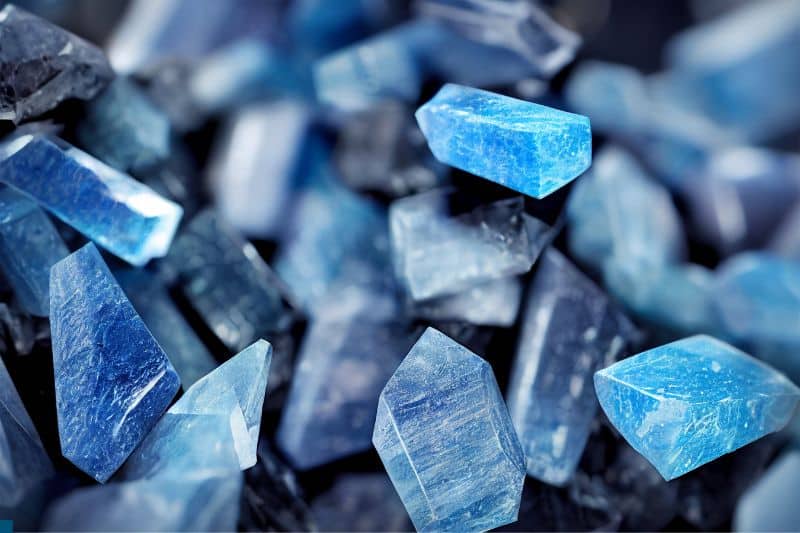
You might be interested in learning about Kyanite, a captivating blue gem, mineral, and crystal. Kyanite, also known as an aluminum silicate mineral, features a unique chemical formula of Al2SiO5. This intriguing mineral is typically found in patchy blue shades, though it can also be discovered in various colors such as gray, white, or even light green in rarer instances.
When you look at Kyanite, you’ll notice that its hues can range from delicate pale blue to deep and vibrant shades of blue. This broad spectrum of colors contributes to its allure and attractiveness.
One essential quality of Kyanite is its use in the production of high-refractory-strength porcelain. You might not know that this type of porcelain can maintain its strength even at extremely high temperatures. A common example of this porcelain comes in the form of white insulators found in spark plugs.
In terms of habit, Kyanite’s characteristics make it relatively easy to distinguish it from other mineral. As you further explore this fascinating blue gem, you’ll uncover Kyanite’s captivating properties and potentially develop a newfound appreciation for this remarkable mineral.
8. Larimar

Larimar, an incredibly unique and mesmerizing gemstone, can instantly captivate anyone’s attention. Derived from a type of pectolite, this beautiful blue stone is predominantly found in the Dominican Republic. If you’re a fan of blue hues, Larimar offers a fantastic range of shades, from soft pastel blues to deep ocean blues. The stunning coloration of Larimar is primarily due to the presence of copper, which substitutes for calcium in its crystal structure.
The appeal of Larimar doesn’t just end with its alluring appearance. This gem has an interesting origin story, and its rarity adds an extra layer of fascination. As a member of the Pectolite family, pectolite gems are generally found in shades of grey and white in various locations across the world. However, only the Larimar variety exhibits that desirable blue coloration, making it truly one-of-a-kind.
When selecting a Larimar gem, you’ll find that the finest specimens are dark blue and translucent. However, sky blue stones featuring cloud-like patterns are also highly sought after. Whether you’re an avid rock collector or simply someone who appreciates the beauty of nature’s creations, Larimar is a gemstone that you won’t want to miss out on.
Remember, when visiting a gemstone market or seeking out Larimar online, it’s essential to verify the authenticity of this rare stone. With its undeniable allure and friendly blue hues, Larimar can truly make a statement in your collection or as an exquisite piece of jewelry.
9. Chalcanthite
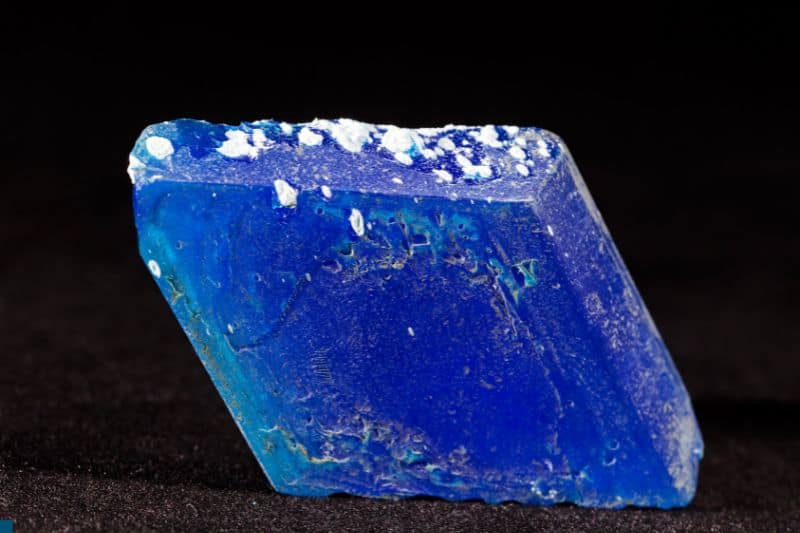
Chalcanthite is a fascinating blue mineral that you might find quite intriguing. It’s known for its vibrant, electric blue color and striking crystalline structure. Formed from copper sulfate pentahydrate, chalcanthite can also be identified by other names like blue stone, blue vitriol, and copper vitriol.
As a lover of all things blue, you’ll be pleased to learn that chalcanthite’s brilliant hue comes from the copper content within it. This dazzling mineral is usually found in arid regions where copper deposits are present, and water evaporates easily. Some noteworthy localities include Chuquicamata and El Teniente in Chile, Minas de Riotinto in Andalusia, Spain, Sao Domingos Mine in Portugal, and Lubin in Legnics, Poland.
When searching for chalcanthite, make sure you’re careful when handling it. The mineral is water-soluble, which means it can dissolve when exposed to water. Also, keep in mind that chalcanthite is toxic due to the copper sulfate it contains, so always wash your hands after handling it and avoid ingesting it.
Aside from its captivating beauty, chalcanthite has practical applications too. It is used as an important ore for copper extraction. The rich blue color of this mineral is also used in pigments for paint and fabric dyes.
There you have it, a brief look at chalcanthite. Remember to be cautious when handling this beautiful blue mineral, but don’t let that stop you from appreciating its rich hue and fascinating crystal formations. Happy rock hunting!
10. Benitoite
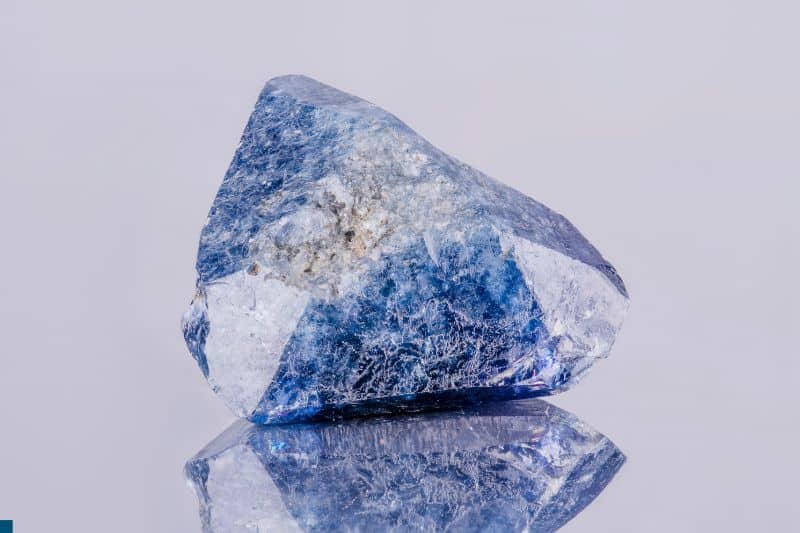
Benitoite is a truly fascinating gemstone that you’ll definitely want to learn more about. This rare mineral is known for its striking blue color, often compared to the hues of sapphire or tanzanite. Due to its scarcity, it’s a fairly unique gem, as it can only be found in a handful of locations.
The sparkling blue of benitoite is not only captivating but also quite valuable. The value of this gemstone typically increases with clarity, meaning eye clean or better scores are particularly desirable. You’ll find that very light and very dark stones hold a lower value on the spectrum.
As you explore benitoite, you may be interested to learn that it often occurs alongside minerals, such as natrolite, neptunite, joaquinite, serpentine, and albite. This beautiful gemstone can be found in specific locations, including San Benito County, California, Japan, and Arkansas. In the San Benito occurrence, benitoite is typically located in natrolite veins within glaucophane schist inside a serpentinite body.
When examining benitoite, you’ll notice the gemstones generally range in color from nearly colorless to violetish-blue. These gems are often faceted and can display a radiant brilliance, making them a stunning choice for jewelry. While rare, the mesmerizing beauty of benitoite is sure to delight collectors and jewelry enthusiasts alike.
11. Cavansite
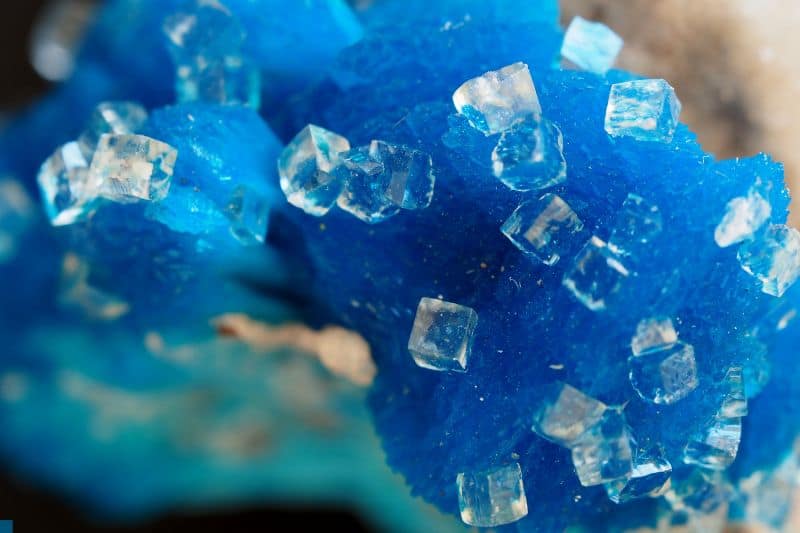
Cavansite is a rare and strikingly beautiful blue mineral that you might find fascinating. Its name is derived from its composition: calcium, vanadium, and silicon. Discovered in the 1960s in Oregon, cavansite has become highly sought after by mineral collectors across the globe due to its unique appearance and rarity source.
As a deep blue hydrous calcium vanadium phyllosilicate mineral, cavansite’s captivating color comes from the presence of vanadium, a metal ion. You will generally find cavansite as a secondary mineral in basaltic and andesitic rocks, where it occurs along with various zeolite minerals source.
To better appreciate this blue gem, keep in mind that it is not just unique in color but also in its properties. Some enthusiasts regard cavansite as a crystal with potential healing properties. While these claims are not scientifically proven, it is always interesting to explore the cultural significance that different gems and minerals hold source.
In your quest to discover more blue rocks, gems, and minerals, remember to admire the beauty of cavansite and its interesting origins. Keep exploring, and you may uncover many more remarkable and awe-inspiring treasures in the world of minerals.
12. Sodalite

Sodalite is a beautiful and unique blue gemstone that can add a touch of elegance to your collection. This tectosilicate mineral has a formula of Na8(Al6Si6O24)Cl2 and is known for its stunning royal blue hues, often used in ornamental pieces. Crystals of sodalite are typically transparent to translucent, while massive samples are opaque.
As a member of the feldspathoid mineral group, sodalite shares similarities with other minerals like nepheline, leucite, nosean, hauyne, lazurite, cancrinite, and melilite. These rare aluminosilicate minerals contain abundant calcium, potassium, or sodium, giving them unique properties that make them stand out among other gemstones.
One interesting fact about sodalite is that it can often be found mixed with calcite, creating a stone that closely resembles lapis lazuli in appearance. This resemblance allows it to be a more budget-friendly alternative to the more expensive lapis lazuli without sacrificing visual appeal.
When considering sodalite for your collection or for use in jewelry pieces, keep in mind that it’s a part of the sodalite mineral group, which includes haüyne, lazurite, and nosean. These minerals are actually found in lapis lazuli, meaning lapis is a rock made up of these materials. However, sodalite and haüyne can also occur separately and even have their own varieties.
So, next time you’re looking to add a touch of blue to your gemstone collection, consider the unique and captivating sodalite mineral. With its vibrant color and striking resemblance to the more expensive lapis lazuli, sodalite is an excellent choice for those who appreciate the beauty of blue gemstones.
13. Lapis Lazuli
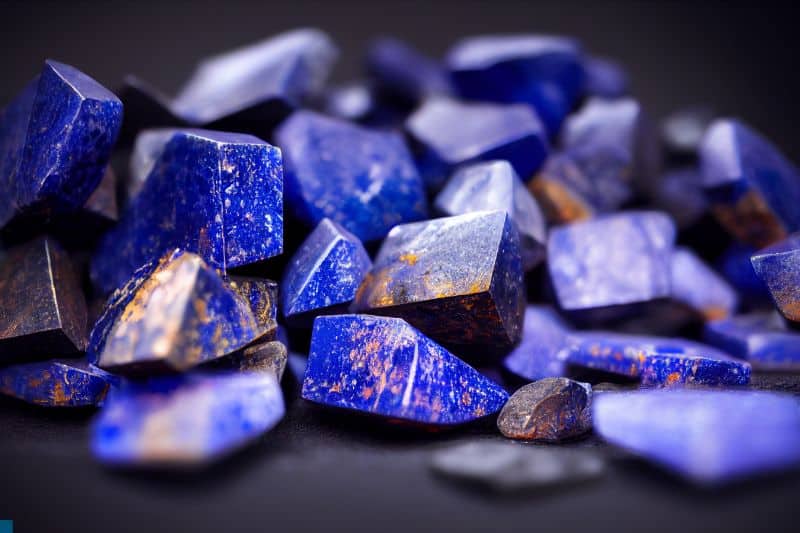
Lapis Lazuli is a fascinating blue metamorphic rock that people have prized for thousands of years. It’s primarily composed of three major minerals – lazurite, calcite, and pyrite. The beautiful blue color you admire is due to the lazurite grains, while the golden flakes of pyrite add attractive contrast to the stone. As a whole, Lapis Lazuli is an aggregate of multiple minerals, giving it its unique characteristics source.
When you come across a piece of Lapis Lazuli, you are holding history in your hands. This ancient rock has been used for various artistic purposes, such as sculpting material, pigment, and ornamental material. The bright royal blue color of high-quality Lapis Lazuli is highly sought after, often making it a costly gem source.
If you are a collector or simply an admirer of blue rocks, gems, and minerals, Lapis Lazuli is an excellent addition to your collection. It can be used for making cabochons, beads, and intricate inlay work in various jewelry and decorative arts. With its vibrant blue hue and gold-specked appearance, Lapis Lazuli is a true classic in the world of blue gemstones.
So the next time you find yourself looking at a piece of Lapis Lazuli jewelry or a raw specimen, remember that you are witnessing not only stunning beauty but also a rich history of human culture and appreciation for our earth’s natural wonders.
14. Turquoise
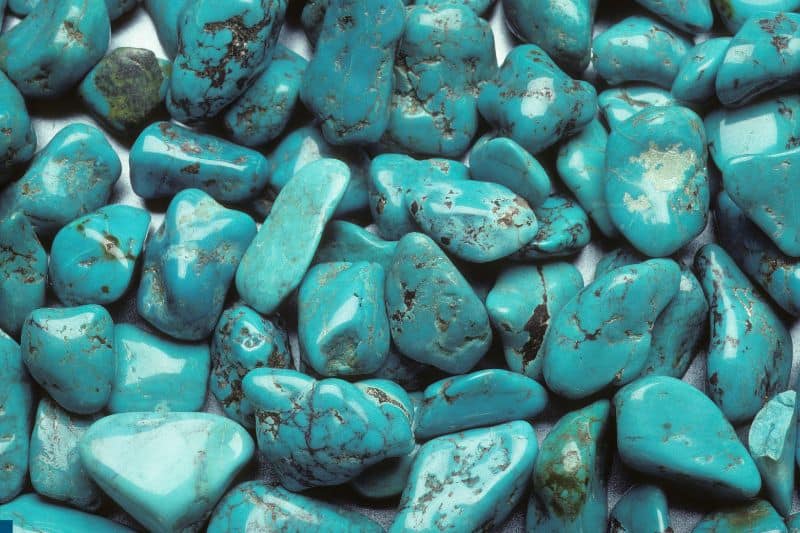
Turquoise is a captivating blue-to-greenish-blue mineral that has been cherished for its beauty throughout history. Its unique hue and distinct properties make it a popular choice for collectors and jewelry enthusiasts alike.
As you explore the world of turquoise, you’ll notice that its color can vary from a deep sky blue to a pale sea green. This is due to the presence of copper and aluminum in the mineral’s composition. The more copper there is, the bluer the turquoise; the more aluminum, the greener it appears. The presence of dark veins or ”matrix” within the turquoise is a result of the host rock where it was formed. These unique features make each turquoise piece one of a kind.
One notable variety of turquoise is the Eilat Stone, which is a greenish-blue mixture of chrysocolla, turquoise, and other copper minerals found near Eilat, Israel. Another example is the Kingman Turquoise, which comes from the Mineral Park Mine near Kingman, Arizona, and is known for its rich color.
Turquoise has been used for thousands of years in various cultures for its ornamental and symbolic value. In many Native American and ancient Egyptian cultures, turquoise was believed to have powerful protective and healing properties, often used to create amulets and talismans.
When selecting turquoise for your collection or jewelry designs, pay attention to its color, texture, and matrix patterns. Ideally, you want to choose pieces with a vibrant hue and minimal matrix, but feel free to embrace your personal preferences. Just remember that the value of turquoise can be significantly affected by its visual appeal and rarity.
In summary, turquoise is a mesmerizing blue to greenish-blue mineral with a rich cultural history and distinct properties. Its unique color variations and patterns make it a captivating and prized gemstone.
15. Topaz
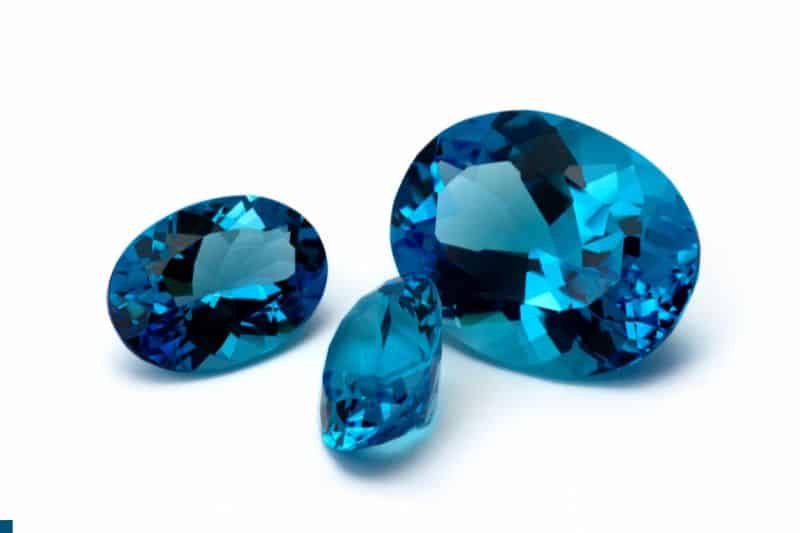
Topaz is a stunning gemstone known for its variety of colors, including the much sought after blue hues. In fact, blue topaz has become one of the most popular choices in today’s jewelry marketplace. It can be found in a wide spectrum of blue colors, ranging from a pale sky blue to a deep, saturated blue.
As you explore the world of blue topaz, you’ll discover it is available in three main shades: Sky Blue, Swiss Blue, and London Blue. Sky Blue topaz has a light tone and saturation, resembling the color of a clear sky. Swiss Blue topaz presents a vibrant, electric blue hue and is considered the mid-range in terms of tone and saturation. Lastly, London Blue topaz boasts a deep, rich hue, with moderate to dark tones and saturation.
Topaz is not only valued for its aesthetic appeal, but also for its durability and affordability. Topaz is an ideal choice for everyday wear With a hardness rating of 8 on the Mohs scale. As you add topaz pieces to your jewelry collection, you’ll appreciate how relatively affordable it is compared to other blue gemstones like sapphire and tanzanite.
But topaz isn’t just about its enchanting blue colors. This versatile gemstone also comes in shades like yellow, orange, brown, pink, red, and green. Reflect on the variety of colors the next time you’re shopping for a piece of jewelry, and consider adding a unique shade of topaz to your collection.
A few interesting facts about topaz to keep in mind:
- It is the birthstone for November.
- Its name is believed to have originated from the Sanskrit word “tapas,” meaning fire.
- Topaz is said to bring good fortune, love, and loyalty to those who wear it.
Now that you’re familiar with the captivating world of topaz let your search for your perfect piece of blue topaz jewelry begin!

